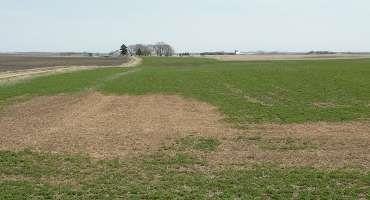By Craig Sheaffer and Troy Salzer et.al

Figure 1. Ice sheet damage to a field of alfalfa.
Ice sheeting can have a lethal effect on forage crop stands (Figure 1). Typically, ice sheeting occurs on poorly drained areas of a field where water congregates, but sometimes it can occur over an entire field. Ice sheets form following freezing of standing water resulting from melting of snow or from rainfall in winter and spring followed by freezing temperatures. In other parts of the state ice sheeting occurs in areas where the soil is frozen and ponds until the frost leaves the soil allowing the water to infiltrate. While once viewed as a problem mainly in central and southern Minnesota, ice sheeting has become a much more significant issue in the last 15-20 years in northeast Minnesota due to changes in snow fall patterns. Ice sheet damage is related to its thickness, duration, and timing during the dormant season.
Mechanism of ice damage
- Because ice has high thermal conductivity and is a poor insulator relative to snow, plants can be exposed to low air temperatures and there is potential for low temperatures to penetrate deep into the soil. Even the most winterhardy alfalfa varieties cannot tolerate long-term air temperatures of less than 15 degrees F.
- Most importantly, ice sheets can cause smothering of alfalfa plants through a restriction of diffusion of air and accumulation of carbon dioxide around plants. Normal pathways of aerobic respiration are disrupted and anaerobic respiration predominates resulting in the accelerated use of energy reserves and accumulation of toxic metabolites like ethanol and lactate. Damage to cell membranes is a factor in injury.
Factors affecting ice encasement damage
- Species and variety differences: Most widely used grass species are more tolerant of ice encasement than legumes (Table 1). Timothy and reed canarygrass are among the most ice tolerant while perennial ryegrass and legumes like alfalfa are the least tolerant. We have also found that Kura clover and birdsfoot trefoil has some resistance to ice sheeting. There are also variety differences in tolerance; however, these have not been documented for all species. More winterhardy alfalfa varieties are thought to have greater tolerance to ice sheeting.
- Duration of coverage: Some very tolerant grasses like timothy and reed canarygrass have been reported to tolerate as much as 8 weeks of ice sheeting. However, legumes like alfalfa and red clover can have significant injury after 4 weeks of coverage.
- Presence of residue or stubble: the presence of leaves and stems protruding through ice can disrupt the ice and serve as a conduit to air diffusion and reduce the effects of ice sheeting.
- Timing of coverage: Ice sheeting can be especially damaging in late winter and early spring when dormancy levels in legumes like alfalfa have decreased
- Ice characteristics and thickness: No quantitative studies have evaluated ice variables on winter injury, but thicker and solid ice sheets are more likely to have lethal effects on forage stands than those that are thin and porous as a result of mixing with snow.
Table 1:
Higher: Reed canarygrass, timothy, smooth bromegrass
Medium: Meadow fescue, tall fescue, orchardgrass, birdsfoot trefoil, Kura clover
Low: Alfalfa, red clover, white clover, perennial ryegrass
Management of ice damage
- Plant alfalfa in well drained or sloping fields where surface water is likely to be rapidly drained. Surface drainage of low-lying areas using tiling might be valuable to get water off the fields and reduce ponding.
- Ice damage is most likely to occur in localized, low-lying portions of fields. Therefore, grasses with greater tolerance to ice sheeting than legumes should be considered for these areas.
- Plant winterhardy forage species and varieties. Ice tolerant grasses planted in mixtures with legumes will provide some insurance of some yield should injury occur in portions of a field.
- Minimize ice sheeting damage risks by not cutting forage in the fall. Stubble remaining in the fall can reduce the effects of ice sheeting as well as reduce the risk of heaving.
- No-till seed into small grain stubble that can disrupt thin ice sheets.
- Mechanical intervention by disruption of ice sheets using rotary hoes or other tillage equipment can increase air flow; however, there is risk of crown damage from these procedures.
- Damaged portions of a field can be seeded with a mixture of red clover (10 lbs/acre) and Italian ryegrass (5 lbs/acre).
Source : umn.edu